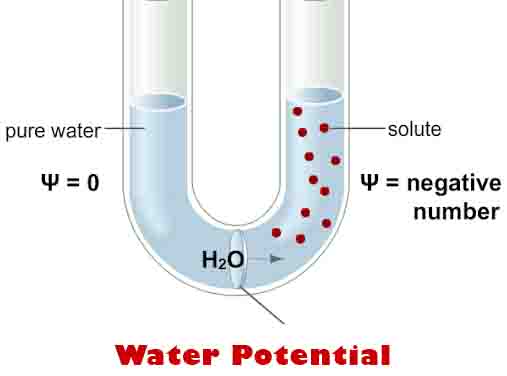Water Potential Definition
Keeping both temperature and pressure constant, water potential is the potential energy of water in a system. In a particular system or environment, it is also a measure of the freedom with which water molecules can move. The unit of measure is kilopascals (kPa) and is represented by the Greek letter Psi (Ψ).
There is a maximum value of zero for water potential, which is that of pure water at atmospheric pressure. Impure water, or water with solutes in it, becomes more negative as the solute molecules attract water molecules and restrict their movement, which restricts the molecules’ ability to move.
Movement of Water Molecules
During osmosis, water moves from areas with a higher (or less negative) water potential to areas with a lower (or more negative) water potential. In the diagram below, the solution around the cell has a higher concentration of solute, so it has a lower water potential than the solution inside the cell.
Having a partially permeable membrane, the cell allows water to move from inside to outside. This will cause water to move from inside to outside of the cell. When living organisms are exposed to this, they can die. Meanwhile, a pure water solution could cause a cell to burst and die.
It is therefore imperative that the concentration of solutes in the cells’ environment is not significantly different from one another.
A plant’s water potential is determined by the amount of solute in its root cells compared to the amount of water in the soil. We see that c decreases as we go up the plant, pulling water into the stems and then to the leaves, where it evaporates constantly to maintain a high solute concentration and a low Ψ.
Our bodies regulate the concentration of solutes through osmoregulation, which controls and maintains water and salt concentrations.
Water Potential Formula
Here is the formula used to calculate :
The sum of all the following is ΨS + ΨP + ΨG + ΨM
It is often simplified into this formula, which is also correct:
Assume ΨS + ΨP
Y stands for a solute potential, p for a pressure potential, g for a gravitational potential, and m for a matrix potential. With increasing pressure, the pressure potential grows as objects or cell membranes exert physical pressure on water molecules.
Plant cells need a positive pressure potential in order to hold their shape and remain rigid, which allows them to hold their shape. Matrix potential also considers forces between water molecules and surfaces and substances, such as soil or cell membranes.
Because water particles are strongly attached to soil particles, the matric potential is always negative and more significant in dry systems, such as soils. Gravitational potential describes how earth’s gravity influences water molecules’ freedom to move. The solute potential decreases as the concentration of solute increases in a solution.
Related Biology Terms
- The arbitrary spread of particles from one region to another where their concentrations are different.
- A hypotonic solution has a higher concentration of solutes than another solution.
- Solute concentration in an isotonic solution is equal to that in another solution.
- Flow resistance of a fluid is measured by its viscosity.

